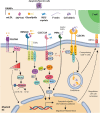C-Type Lectin-Like Receptors: Head or Tail in Cell Death Immunity
- PMID: 32133013
- PMCID: PMC7040094
- DOI: 10.3389/fimmu.2020.00251
C-Type Lectin-Like Receptors: Head or Tail in Cell Death Immunity
Abstract
C-type lectin-like receptors (CLRs) represent a family of transmembrane pattern recognition receptors, expressed primarily by myeloid cells. They recognize not only pathogen moieties for host defense, but also modified self-antigens such as damage-associated molecular patterns released from dead cells. Upon ligation, CLR signaling leads to the production of inflammatory mediators to shape amplitude, duration and outcome of the immune response. Thus, following excessive injury, dysregulation of these receptors leads to the development of inflammatory diseases. Herein, we will focus on four CLRs of the "Dectin family," shown to decode the immunogenicity of cell death. CLEC9A on dendritic cells links F-actin exposed by dying cells to favor cross-presentation of dead-cell associated antigens to CD8+ T cells. Nevertheless, CLEC9A exerts also feedback mechanisms to temper neutrophil recruitment and prevent additional tissue damage. MINCLE expressed by macrophages binds nuclear SAP130 released by necrotic cells to potentiate pro-inflammatory responses. However, the consequent inflammation can exacerbate pathogenesis of inflammatory diseases. Moreover, in a tumor microenvironment, MINCLE induces macrophage-induced immune suppression and cancer progression. Similarly, triggering of LOX-1 by oxidized LDL, amplifies pro-inflammatory response but promotes tumor immune escape and metastasis. Finally, CLEC12A that recognizes monosodium urate crystals formed during cell death, inhibits activating signals to prevent detrimental inflammation. Interestingly, CLEC12A also sustains type-I IFN response to finely tune immune responses in case of viral-induced collateral damage. Therefore, CLRs acting in concert as sensors of injury, could be used in a targeted way to treat numerous diseases such as allergies, obesity, tumors, and autoimmunity.
Keywords: C-type lectin-like receptors; cross-presentation; dead cells; sterile inflammation; tissue injury.
Copyright © 2020 Drouin, Saenz and Chiffoleau.
Figures

Similar articles
-
From structure to function - Ligand recognition by myeloid C-type lectin receptors.Comput Struct Biotechnol J. 2022 Oct 20;20:5790-5812. doi: 10.1016/j.csbj.2022.10.019. eCollection 2022. Comput Struct Biotechnol J. 2022. PMID: 36382179 Free PMC article. Review.
-
Sensing Tissue Damage by Myeloid C-Type Lectin Receptors.Curr Top Microbiol Immunol. 2020;429:117-145. doi: 10.1007/82_2019_194. Curr Top Microbiol Immunol. 2020. PMID: 31974758
-
C-Type Lectin-Like Receptors As Emerging Orchestrators of Sterile Inflammation Represent Potential Therapeutic Targets.Front Immunol. 2018 Feb 15;9:227. doi: 10.3389/fimmu.2018.00227. eCollection 2018. Front Immunol. 2018. PMID: 29497419 Free PMC article. Review.
-
DNGR-1, a Dendritic Cell-Specific Sensor of Tissue Damage That Dually Modulates Immunity and Inflammation.Front Immunol. 2020 Feb 7;10:3146. doi: 10.3389/fimmu.2019.03146. eCollection 2019. Front Immunol. 2020. PMID: 32117205 Free PMC article. Review.
-
Antibody-mediated targeting of antigen to C-type lectin-like receptors Clec9A and Clec12A elicits different vaccination outcomes.Mol Immunol. 2017 Jan;81:143-150. doi: 10.1016/j.molimm.2016.12.010. Epub 2016 Dec 12. Mol Immunol. 2017. PMID: 27978488
Cited by
-
Self-recognition through Dectin-1 exacerbates liver inflammation.Genes Cells. 2024 Apr;29(4):316-327. doi: 10.1111/gtc.13106. Epub 2024 Feb 22. Genes Cells. 2024. PMID: 38385597 Free PMC article.
-
The SAP130/Mincle axis was involved in sevoflurane-induced neuronal death and microglial activation in juvenile mice.Front Pharmacol. 2025 Jul 28;16:1647329. doi: 10.3389/fphar.2025.1647329. eCollection 2025. Front Pharmacol. 2025. PMID: 40792209 Free PMC article.
-
Chromosome-Scale Genome of Masked Palm Civet (Paguma larvata) Shows Genomic Signatures of Its Biological Characteristics and Evolution.Front Genet. 2022 Jan 21;12:819493. doi: 10.3389/fgene.2021.819493. eCollection 2021. Front Genet. 2022. PMID: 35126472 Free PMC article.
-
Association Between Diabetes Mellitus-Tuberculosis and the Generation of Drug Resistance.Microorganisms. 2024 Dec 20;12(12):2649. doi: 10.3390/microorganisms12122649. Microorganisms. 2024. PMID: 39770852 Free PMC article. Review.
-
Exploring Clec9a in dendritic cell-based tumor immunotherapy for molecular insights and therapeutic potentials.NPJ Vaccines. 2025 Feb 7;10(1):27. doi: 10.1038/s41541-025-01084-2. NPJ Vaccines. 2025. PMID: 39920156 Free PMC article. Review.
References
-
- Lockshin RA, Williams CM. Programmed cell death-II. endocrine potentiation of the breakdown of the intersegmental muscles of silkmoths. J Insect Physiol. (1964) 10:643–9. 10.1016/0022-1910(64)90034-4 - DOI
Publication types
MeSH terms
Substances
LinkOut - more resources
Full Text Sources
Research Materials

